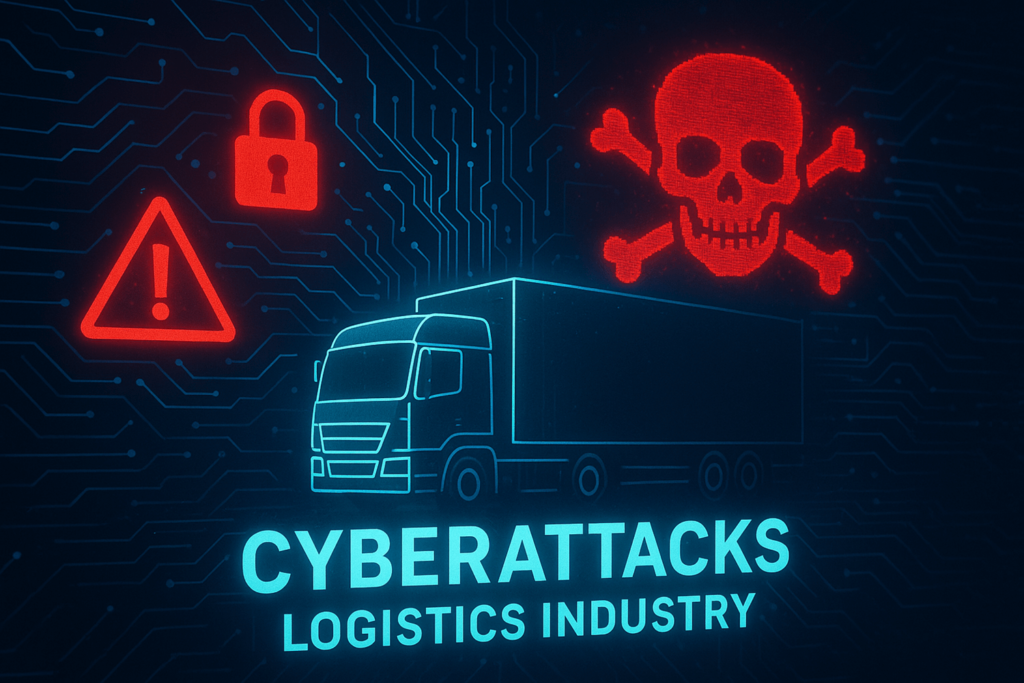
Imagine this: 25% of the world’s food supply is delayed—not by weather, port congestion, or labor strikes, but by a single cyberattack.
This isn’t fiction. It’s what happened to Maersk, the world’s largest shipping company, when it was hit by the NotPetya ransomware attack in 2017. In minutes, 56,000 devices were encrypted, operations halted, and global trade felt the shockwave—$10 billion in losses, including $350 million for Maersk alone.
Fast forward to 2025, and the cyber threat landscape in logistics is even more dangerous, complex, and frequent.
Why Logistics Is a Prime Target for Cyberattacks
The logistics industry is an intricate web of ports, carriers, customs, freight forwarders, and real-time digital systems—all sharing sensitive, high-value data across APIs and networks.
According to 2024–2025 maritime cybersecurity reports:
- Over 23,400 malware attacks and 178 ransomware incidents were recorded in the logistics sector in 2024 alone.
- 64.33% of these cyberattacks specifically targeted supply chain disruption.
- The United States, followed by Ukraine, remains the most targeted country for logistics-related cyber threats.
The scale of damage is growing, with the average cost of a major supply chain cyberattack exceeding $20 million in 2025.
Real-World Cyber Incidents in Global Logistics
🛑 Maersk, 2017 – The Wake-Up Call
- Attack type: Ransomware (NotPetya)
- Impact: Global shutdown of operations, massive container congestion, terminal closures
- Financial cost: $350 million for Maersk, $10 billion across global supply chains
🚢 Nagoya Port, Japan – July 2023
- Attack type: Ransomware (LockBit Group)
- Impact: Operations at Japan’s largest port halted for 3 days; significant delays in car exports
🏗️ DP World, Australia – November 2023
- Impact: 40% of national container trade stranded; 30,000 containers stuck at 5 ports
- Downtime: 7+ days
🌐 2024 Global Port Attacks
- Coordinated cyberattacks affected ports across Europe and Southeast Asia, resulting in over $500 million in losses from disrupted cargo routing and customs clearance.
How These Attacks Happen: Understanding the Method
Most cyberattacks on logistics companies occur through:
- Supply Chain Breaches: Compromised third-party vendors with API access, as seen in Maersk’s case.
- Outdated Operational Technology (OT): Legacy systems in ports and vessels are ripe targets.
- Unsecured IoT Devices: Tracking tools and navigation systems with poor security protocols.
- Phishing and Social Engineering: Still the most common entry point for ransomware.
Top Cybersecurity Risks in Logistics Today
- Real-time system hijacking
- Ransomware encrypting shipping manifests
- API exploitation in customs clearance
- Data theft from cargo tracking systems
- Operational downtime across multimodal transport
Protecting Logistics Operations from Cyber Threats
You can’t control every vulnerability in a connected ecosystem—but you can minimize risk. Here’s how:
1. Assess Supply Chain Risk
Audit all digital touchpoints, including third-party APIs and legacy systems.
2. Strengthen Access Controls
Implement multi-factor authentication (MFA) and role-based access across critical systems.
3. Encrypt Everything
Protect sensitive data in transit and at rest with robust encryption.
4. Update, Patch, Repeat
Legacy systems are low-hanging fruit for attackers. Patch all known vulnerabilities regularly.
5. Train Your Teams
Educate staff on phishing, deepfakes, and suspicious activity.
6. Develop an Incident Response Plan
Know who does what in a crisis. Ensure backups are clean and test recovery protocols.
7. Real-Time Monitoring
Invest in threat detection platforms that flag intrusions in real time.
8. Secure Third-Party Partners
Include cybersecurity compliance in vendor contracts. Your weakest partner can bring down your entire operation.
Economic Impact: Can Businesses Survive a Cyber Hit?
A recent CyberRisk Alliance report reveals that 6 in 10 businesses hit by major cyberattacks shut down within 18 months. In logistics, the stakes are even higher due to the ripple effect on production, inventory, retail, and customer delivery.
With trillions of dollars moving through global supply chains annually, a single hour of downtime can translate to millions in losses.
Is 100% Cybersecurity Even Possible?
Short answer: No.
In such a digitally interconnected landscape, absolute security doesn’t exist. But with layered defenses, resilient infrastructure, and proactive planning, the logistics industry can build robust cyber immunity.
Final Thoughts: Cybersecurity is the New Port Security
The age of port guards and locked cargo is over. Today, data is the cargo and firewalls are the docks. As global trade continues to digitize, logistics companies must prioritize cybersecurity as much as speed, cost, and delivery reliability.
Tell Us Your Story
Have you faced a cyberattack in your logistics operations?
What measures have helped you protect your digital cargo?
🧠 Share your experience in the comments below. #LogisticsCybersecurity #MaerskHack #CyberAttackLogistics #RansomwareShipping #MaritimeCyberRisk #SupplyChainSecurity #PortCyberThreats #GlobalTradeDisruption #OTSecurity #CyberResilienceLogistics











